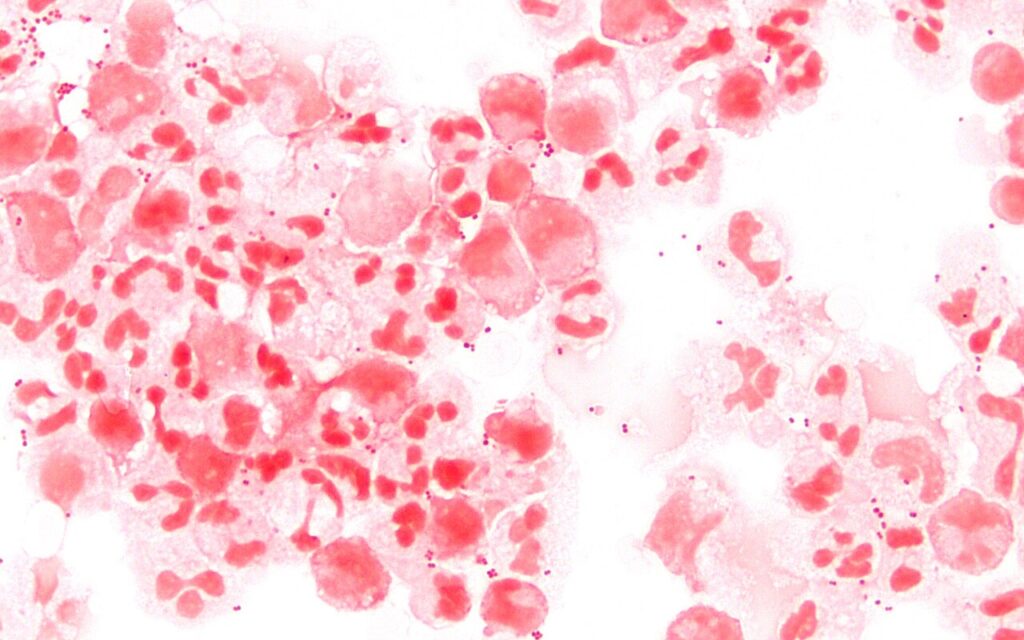A 19-year-old college student presents to the emergency department with a sudden onset of high fever, headache, and a rapidly progressing purpuric rash. The patient is also experiencing photophobia, nausea, and myalgias. Symptoms began approximately 12 hours ago, starting with a sore throat and fever.
From History
- Chief Complaint: High fever and rash.
- History of Present Illness:
- Onset: 12 hours prior
- Initial Symptoms: Sore throat, fever
- Progression: Headache, photophobia, nausea, myalgias, purpuric rash
- Past Medical History: Unremarkable
- Medications: None
- Allergies: No known drug allergies
- Social History: College student, lives in dormitory
- Travel History: No recent travel
- Contact History: Several sick contacts in the dormitory with flu-like symptoms
Examination
General Appearance
- Appears acutely ill
- Lethargic and irritable
Vital Signs
- Temperature: 39.5°C (103.1°F)
- Heart Rate: 120 beats per minute
- Blood Pressure: 90/60 mmHg
- Respiratory Rate: 24 breaths per minute
- Oxygen Saturation: 94% on room air
Skin
- Purpuric rash primarily on the trunk and lower extremities
- No signs of blanching on pressure
Neurological
- Photophobia present
- Neck stiffness noted
- Positive Brudzinski’s sign
Cardiovascular
- Tachycardia
- No murmurs or additional heart sounds
Respiratory
- Clear breath sounds bilaterally
Abdomen
- Soft, non-tender, no organomegaly
Labs and Imaging
Laboratory Tests
- Complete Blood Count (CBC):
- White Blood Cell (WBC) count: 18,000/mm³ (normal: 4,000-11,000/mm³)
- Hemoglobin (Hgb): 13.5 g/dL (normal: 13.8-17.2 g/dL)
- Hematocrit (Hct): 40% (normal: 38.3-48.6%)
- Platelets: 90,000/mm³ (normal: 150,000-450,000/mm³)
- Coagulation Profile:
- Prothrombin Time (PT): 16 seconds (normal: 11-13.5 seconds)
- Partial Thromboplastin Time (PTT): 45 seconds (normal: 25-35 seconds)
- International Normalized Ratio (INR): 1.3 (normal: 0.8-1.1)
- Comprehensive Metabolic Panel (CMP):
- Sodium (Na): 134 mEq/L (normal: 135-145 mEq/L)
- Potassium (K): 4.0 mEq/L (normal: 3.5-5.0 mEq/L)
- Blood Urea Nitrogen (BUN): 18 mg/dL (normal: 7-20 mg/dL)
- Creatinine: 0.9 mg/dL (normal: 0.6-1.2 mg/dL)
- Glucose: 110 mg/dL (normal: 70-100 mg/dL)
- Blood Cultures:
- Pending, but critical for diagnosis
- Lumbar Puncture:
- Opening Pressure: Elevated at 250 mm H₂O (normal: 70-180 mm H₂O)
- White Blood Cell Count in CSF: 1,200 cells/µL (normal: 0-5 cells/µL)
- Protein in CSF: 100 mg/dL (normal: 15-45 mg/dL)
- Glucose in CSF: 25 mg/dL (normal: 45-80 mg/dL)
- Gram stain of CSF: Gram-negative diplococci

Imaging
- Chest X-ray: Clear
- CT Scan of Head: No acute abnormalities
Diagnosis
Differential Diagnosis
- Meningococcemia
- Sepsis from other bacterial infection
- Viral exanthem
- Idiopathic thrombocytopenic purpura (ITP)
Confirmatory Diagnosis
- Meningococcemia: Confirmed by identification of Neisseria meningitidis in blood and CSF cultures.
Management
Immediate Treatment
- Antibiotics:
- Empirical intravenous (IV) antibiotics initiated immediately (e.g., Ceftriaxone or Penicillin G)
- Supportive Care:
- IV fluids to manage hypotension
- Antipyretics for fever
- Close monitoring in an intensive care unit (ICU) setting
Further Management
- Public Health Measures:
- Prophylactic antibiotics for close contacts (e.g., Rifampin, Ciprofloxacin)
- Notification to public health authorities for potential outbreak management
Long-term Management
- Follow-up Care:
- Monitoring for potential complications such as septic shock, disseminated intravascular coagulation (DIC), and long-term neurological sequelae.
- Vaccination for close contacts and community members, if indicated.
Conclusion
Meningococcemia is a life-threatening condition requiring rapid diagnosis and immediate treatment. High clinical suspicion, prompt initiation of empirical antibiotics, and supportive care are essential for improving patient outcomes. Early recognition and intervention, coupled with public health measures, can mitigate the spread and impact of this serious infection.
